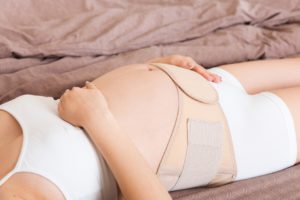Despite celebrities such as Kim and Kortney Kardashian, Cardi B, Amber Rose, and Nicki Minaj posting pictures of their postpartum compression girdles, belly wrapping is not just a celebrity beauty fad. Asian, European, and Latin American cultures all have traditions of binding women’s bellies with fabric after delivery dating back centuries. Modern medicine calls belly wraps abdominal compression binders and uses them to speed recovery after back and abdominal surgeries. But what are the benefits of wearing a postpartum compression girdle? Should it be an essential part of your postpartum recovery plan?
How Does A Postpartum Girdle Promote Recovery From Childbirth?
A postpartum girdle supports and holds your abdominal organs in the right position so that they can work correctly until your abdominal muscles regain their strength. Postpartum girdles have can contribute to your postpartum recovery in several other ways, including:
- Reducing swelling and bloating right after delivery.
- Lightly compressing your uterus to help it shrink back to its normal size.
- If you had a C-section, relieving pressure on your incision, helping the incision heal, and decreasing your pain when coughing or moving.
- Stabilizing your pelvic floor, relieving back pain, and improving posture.
- Regaining normal activity levels faster and with less pain after a C-section. Some women report that wearing their compression girdles for exercise helps them feel more comfortable.
- To help you feel more confident by covering and smoothing lose and floppy belly skin women can have postpartum.
Some health insurance companies may cover the cost of postpartum abdominal girdles, especially if you have postpartum conditions you are being treated for such as back pain, pelvic pain or diastasis recti.
What a Postpartum Girdle Can’t Do
Magical social media influencer thinking aside, wearing a postpartum girdle cannot:
- Help you lose weight faster.
- Regain your pre-pregnancy figure without exercise or diet changes
- Make you skinnier
Time, exercise, and a healthy diet are the most direct routes back to the body you had before pregnancy and childbirth. Body acceptance, self-compassion, and appreciation for your amazing life-giving body also go a long way to helping you feel better physically and emotionally.
Who Can a Postpartum Compression Girdle Help The Most?
Not every postpartum mom will be excited to squeeze into an elastic corset, but for some, this postpartum accessory may actually help them feel better more quickly. Consider trying out a postpartum compression girdle if you:
- Have diastasis recti
- Have a cesarean section
- Have back or pelvic pain during pregnancy
How Long Will I Need A Postpartum Compression Girdle?
Wearing an abdominal binder, belly wrap or compression girdle is a short-term way to help you feel more comfortable, less pain, and help you become active again postpartum. Don’t wear your postpartum compression girdle for longer than 6-8 weeks postpartum, regardless of whether or not you have had a C-section.
If you continue to have low back pain, pelvic pain, incision pain, or diastasis recti, consider seeing a physical therapist. Specialized pelvic floor physical therapists can offer much more effective treatments for specific postpartum conditions such as diastasis rectus, pelvic pain, or urinary incontinence.
How To Shop for a Postpartum Girdle
Keep in mind when you are shopping for your postpartum compression girdle you will be overwhelmed too many options, as is the case when shopping for anything baby-related. You may see postpartum compression girdles called any of the following:
- Belly Wrap
- Postpartum Corset
- Post-Pregnancy Recovery Binder
- Abdominal Compression Binder
Here are some other shopping tips from moms-in-the-know:
- Although typically more expensive and less sexy, the medical-grade compression girdles usually have industrial-strength elastic for superior squeezing. This can mean a tighter, but better fit, more support and less unsightly bunching.
- Avoid girdles with Velcro and look for hooks instead because velcro can be noisy and less secure.
- Take note where the seams are on the girdle because they may become uncomfortable over a C-section incision or scar.
- Read the washing instructions carefully. The more durable the construction the better your girdle will hold up for many washes.
- If you have had a C-section, consider a post-C-section specific postpartum girdle designed to minimize pressure on your incision and made of breathable fabric.
- If in doubt about your size, choose the smaller size because the elastic in girdles will stretch with time and washing.
- Consider cost and that you may need to buy more than one girdle because your body shape can change dramatically in the 6-8 weeks postpartum time frame.
- Try more than one brand and size to find the best fit. Investigate return policies carefully before purchasing, especially if ordering by mail. If you are a super-organized prenatal mom, buy several options, leave the tags on, and then make your decision after baby arrives.
- Postpartum compression girdles may fit better than general abdominal compression binders used for all abdominal surgeries because they are designed specifically for postpartum moms’ needs and shapes.
One Way to Feel More Comfortable in Your Postpartum Body
A postpartum compression girdle does not need to be on your postpartum need-to-buy list. Think of if more like a tool or an accessory that helps some women. If you have back pain, pelvic pain, a C-section, or diastasis recti, then wearing a postpartum compression girdle might be worth the hassle of shopping for and wearing one.
For many women, postpartum compression girdles help them move more comfortably and sooner after their delivery. Unfortunately, it is not a magic beauty tool that can return your body to its pre-baby shape or size. It is normal for your body to look and feel differently after giving birth. If wearing a postpartum girdle helps boost your confidence and self-esteem or makes moving comfortably through your postpartum world more feasible, than perhaps a postpartum compression girdle is just what you’ve been looking for!

